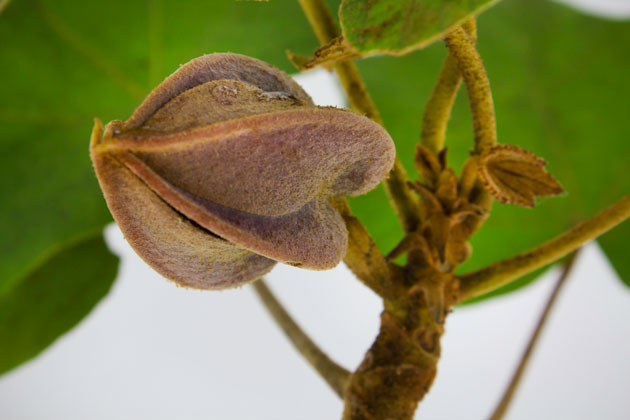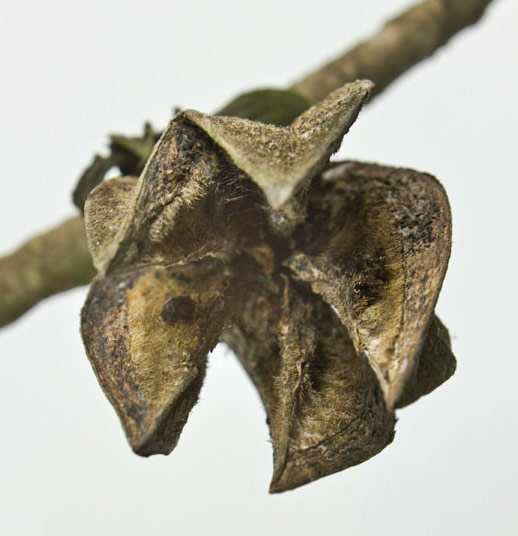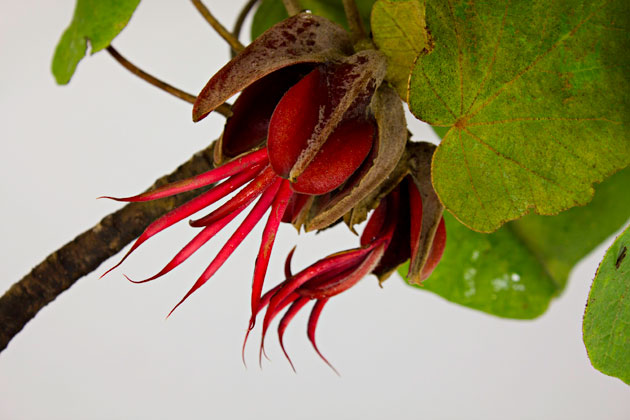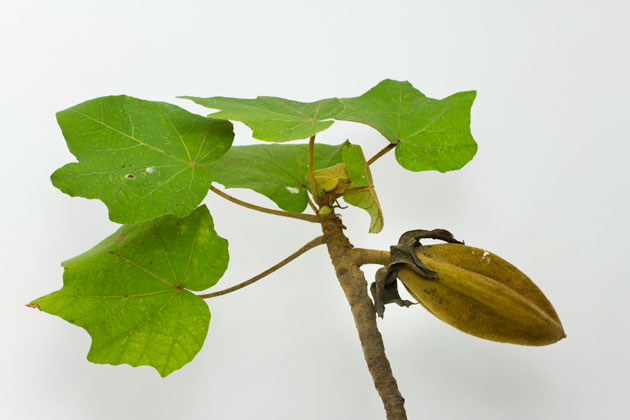The canak tree, Chiranthodendron pentadactylon Laar., belongs to the family Sterculiaceae. Other names which can be found are Cacpalxochitl, Macpalxochitl, Mapilxochit, Palo de tayyo, Ranac, Tayuyo, Papasuchil and Teyagua (Cáceres 2000 and 2009). Every name is different in the villages, some may apply and some may not. For now we just have a list, but one of the FLAAR Future Projects is to investigate how the names, uses and ways to collect the flower vary among the villages.
Closed manita tree flower with leaves, photo taken at FLAAR Studio by Sofia Monzon with a Canon EOS Rebel T2i on May 2012.
According to Cáceres (2000 and 2009) this tree appears in colonial text from De La Cruz and Badiano, Hernandez and Sahagun, but they don’t describe much about their uses. Just describe the tree , just the tree itself. It was first described in Guatemala in 1801, later Humbolt and Bonpland tried to reproduce and take it to Europe, but they didn’t have success weren't successful (Cáceres 2000).
Is a slow growing tree and hard to cultivate. Most of the medicinal material is collected exclusively from wild trees. The flowers are collected from the ground or from the tree from August to December (Cáceres 2000 and 2009).
Habitat
This tree is native from the south of Mexico all the way through Honduras. It grows in mixed humid and mountain fields, in disassembled lands or cloudy forests at heights between 2,000 and 3,000 meters above sea level. In Guatemala it has been found in Chimaltenango, El Progreso, El Quiché, Guatemala, Huehuetenango, Quetzaltenango, Sacatepéquez, San Marcos, Sololá, Totonicapán and Zacapa.
Stems of Chiranthodendron pentadactylon, photo taken at FLAAR Studio by Sofia Monzon with a Canon EOS Rebel T2i on May 2012.
Maya uses today
Because of the odd shape of its flowers that resemble a human open hand there was a time in which it was revered. For its curious appearance, this tree is has been revered and even feared among time. Until Furthermore, the tree itself acquired a magical and religious significance (Villar 2005).
Manita tree flower open, it resembles a human hand. photo taken at FLAAR Studio by Sofia Monzon with a Canon EOS Rebel T2i on May 2012.
It's believed that the Mayas use this nectar flower to produce honey. Today the tree leaves are used to wrap tamales, cheese and other foods. One of the principal uses of the tree is as shade and ornament in parks and gardens because of the beauty of the flowers. The wood is used in carpentry (Cáceres 2000 and 2009).
This tree is now considered as medicinal. The flower is mainly used (fresh or dried) to treat heart conditions, diarrhea, nerve disease or epilepsy. Ancient Mayas used to cook the leaves and flower nectar to treat eye inflammation and ease the pain in hemorrhoid (Cáceres 2000 and 2009). The cooked leaves, together with the bark and the flowers are used for cataplasm and for baths to treat hemorrhoids, ophthalmic and chronic ulcers.
Canak leaves and closed bud. photo taken at FLAAR Studio by Sofia Monzon with a Canon EOS Rebel T2i on May 2012.
Taking pictures in the wild and studio by FLAAR staff
We at FLAAR dedicate to seek for all the plants that were useful for the Mayas and investigate if they are still been used by the people nowadays. There are many sources of income for low-income families in native plants which are underutilized today. So we are making lists of every plant of Guatemala which has economic potential.
Every time we visit a village market we see dried manitas flowers being sold as medicine. But finding an actual tree, and finding it when it was blooming, was not easy. The trees are common but only in a restricted eco-zone, on the flanks of volcanos. Thus it was very helpful when a kind family allowed us to photograph the manitas tree in their garden, not far from Guatemala City. So now we have this web page and a separate PDF. All the photographs are by Sofia Monzon.
Taking wild pictures of flowers and trees in the wild is a hard task, since sometimes the wind moves the branches and the flowers too much, making them impossible to keep in focus. Fortunately the wind was not too strong, and also it was possible to do photography of some of the flowers in our studio. If you would like to see our pictures look up for the illustrative PDF’s of the Manitas tree.
Taking pictures of flowers and treesin the wild is a hard task, since sometimes the wind moves the branches and the flowers too much, making them impossible to focus. Fortunately we have taken pictures during good seasons. If you would like to see our pictures look up for the illustrative PDF's of the Manitas tree, and look up for our informative PDF's about the medical use of the Canak tree.
BIBLIOGRAPHY
- 2000
- Plantas de uso medicinal en Guatemala. Editorial Universitaria, Universidad San Carlos de Guatemala. 402 pages.
- 2009
- Vademécum Nacional de Plantas medicinales. Editorial Universitaria. Universidad San Carlos de Guatemala. 313 pages.
- 2005
- Guatemala Arboles Mágicos y Notables. Editorial Evergraficas, S.L. España. 143 pages.

















































































